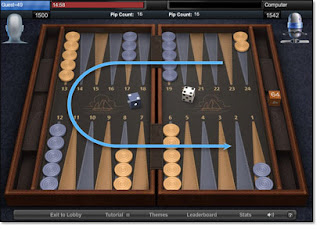Mission US - Mission 2: "Flight to Freedom"
General information:
In Mission 2: "Flight to Freedom," a player takes on the role of Lucy, a 14-year-old slave in Kentucky, navigating her escape and journey to Ohio.
You start at the beginning with the Prologue and play to unlock each successive part by completing the one before it. Play basically involves listening to what's happening in the story at the moment and who Lucy is interacting with at the time (captions are included for whomever Lucy is interacting with so you don't need speakers). You then have choices provided on the screen as to how you respond (click to choose).
There are also options to click on objects in Lucy's environment that, when clicked on , give you a little history of that area, or, dialog from someone in that area (say if you were traveling and clicked on a farm, you could gain info regarding that place).
You (Lucy) earn journey badges along the way, based on decisions you make. There aren't any "right" answers, but some of the choices you make will have lasting consequences. You use these badges to determine Lucy's ultimate journey in the game's epilogue. At the end of each part you will see which badges you unlocked and which you did not.
Analysis based on Flow Theory:
In this section, I'll use elements of flow, based on Csikszentmihalyi's Flow Theory, to analyze this game.
- Task that the learners can complete - YES:
- The overall game itself was structured such that you knew from the beginning of play how many sections were involved in the game (Prologue, Parts 1-5, and Epilogue). This game did a very good job of explaining steps to allow you to knowledgeably play (not just click buttons until something happened) without going into too many details and making me lose interest (I don't want to have to work too hard to get into FLOW). I was never stuck wondering what I was supposed to do next.
- Ability to concentrate on task - YES:
- The simplicity of the graphics and sound (great voice-overs and music) interested me from the beginning (and I've never been big on RPG or Strategy games). Because of the ease of moving around the screen and the fact there wasn't a time limit, I found myself wandering around each screen before making choices, just to see what was there. Each object I chose to learn more about made me feel more involved in the game and wanting to find out more!
- Task has clear goals - YES:
- As you move through play, Lucy is given "tasks" to perform. There "tasks" are actually separated on the screen by "Community tasks" and "Plantation tasks" and show up as a ghosted color (needing to be completed). If you hover your mouse over a task, you see what that task is (again, everything was super self-explanatory and it made performing the tasks easier). When a task was completed, it changed color (lit up more so). I liked this organization of the tasks - could be part of my personality too that I liked being able to "check" things off my list!
- As I mentioned in the description of game play above, Lucy earns journey badges based on decisions she makes along her way. These badges are ultimately used in the epilogue of her story. She also collects items that are stored in her Pack (the biggest thing I saw used here was food she had collected that supplemented her when she escaped).
- Task provides immediate feedback - YES:
- For example, I had a task to take care of the chickens. When in the coop, I had choices as to how I was going to accomplish this task, as shown in the figure below.
- I chose to "waste time" and play with some of my favorite hens while I was in there. After selecting this option, I got immediate feedback from that decision, seen in the figure below:
- Deep but effortless involvement - SOMEWHAT:
- This game was created to teach and so, while the "world" isn't what we currently live in, this era is part of history, Still, the structure of the game allowed for deep but effortless involvement.
- Exercising a sense of control over their actions - SOMEWHAT:
- You had control over the decisions you made from a predetermined set of choices. Since it's a game structured on history, the path that you take depending on your choices can start to narrow due to being structured around that particular time period. You quickly learned that complete disobedience did not get you far in anyone's book during this time (the Plantation owner or fellow slaves).
- Concern for self disappears during flow - SOMEWHAT:
- This game is a role playing game yet is structured on real life time periods in history. I found I was making decisions based on my concern for my character (as myself) and those she cared about. That being said, it was still just a game and the consequences realized in the game did not become my reality.
- Sense of duration of time is altered - YES:
- Some parts of the game took place over a single day, others had a year or more advance in between scenes/parts. I did find myself becoming caught up in the story and lost track of time as to how long I'd played the game.








